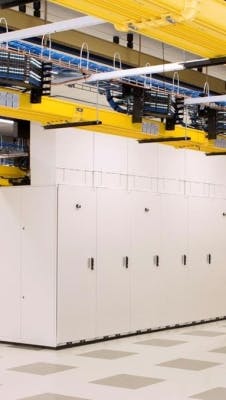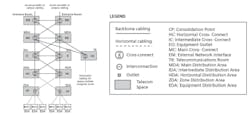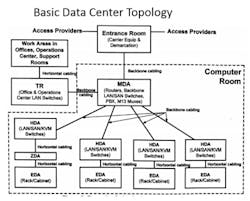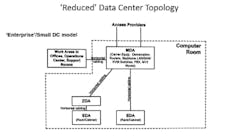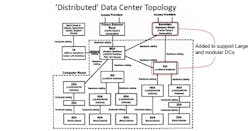For professionals responsible for the specification, design, installation, or administration of fiber-optic cabling systems in data centers, a number of standards can be beneficial guidelines whether a cabling system is being planned, installed, or updated.
In a series of web-delivered seminars broadcast in summer 2018, Cabling Installation & Maintenance provided information on a number of standards and their applications. This article highlights information from those seminars that specifically relate to the deployment of fiber in data centers.
On July 12, the Telecommunications Industry Association’s (TIA) Fiber Optic Technology Consortium (FOTC) delivered the seminar “Meeting Data Center Communications Needs Through Standardized Fiber-Optic Cabling Systems.” Representing the FOTC were Robert Reid, senior technology manager for data center connectivity with Panduit, and Rodney Casteel, engineer – senior for field applications with CommScope. Casteel is chairman of the TIA FOTC.
Reid’s presentation focused on the specifications within, and application of, the TIA-942-B Telecommunications Infrastructure Standard for Data Centers. The standard’s “B” revision was approved for publication in June 27 and released for purchase in August 2017. Reid explained that 942-B incorporates the first addendum that was made to the standard’s “A” revision, which specifies cabling guidelines for data center fabrics. Those guidelines are now included as informative annexes in TIA-942-B. The new standard also incorporates 16- and 32-fiber MPO-style connectors, and wideband multimode fiber (also known as OM5).
Within the TIA-942 standard is a generic data center hierarchy, specifying backbone and horizontal cabling, crossocnnects and interconnects. The hierarchy (illustration immediately below) includes “areas” of differing connection density and function; they include the main distribution area (MDA), intermediate distribution area (IDA), horizontal distribution area (HDA), zone distribution area (ZDA), and equipment distribution area (EDA).
The standard also includes different topologies (illustrated below), each of which incorporates elements of the generic hierarchy. For example, the basic data center topology illustrated in the standard includes one MDA, multiple HDAs, multiple EDAs and a ZDA. A reduced data center topology—which uses are likely to find appropriate for enterprise-class or small data centers—includes one MDA, one ZDA, and two EDAs. A distributed topology includes multiple IDAs, HDAs, ZDAs, and EDAs. That topology also includes an optional secondary entrance room; the combination of that secondary entrance room, an IDA, and the HDAs/ZDA/EDAs stemming from it can support large and modular data centers.
The data center fabrics outlined in TIA-942-B’s informative Annex H detail switch-to-server architectures including hierarchical star, fat tree (also commonly called leaf/spine), and full mesh.
OM5 fiber is specified in TIA-492AAAE, which was published in mid-2016. TIA-492AAAE specifies 50/125-micron laser-optimized fiber that is optimized for enhanced performance for single-wavelength or multi-wavelength transmission systems with wavelengths between 850 and 953 nm. Its effective modal bandwidth (EMB) is 4700 MHz·km at 850 nm and 2470 MHz·km at 953 nm.
The essential value proposition of OM5 wideband multimode fiber (WBMMF) is that rather than needing four separate fibers to transmit four distinct optical signals, the signals can be sent down a single fiber over four separate operating windows using short wavelength division multiplexing (SWDM) technology.
The SWDM Alliance published multi-source agreements (MSAs) for the transmission of 40-Gbit/sec and 100-Gbit/sec using SWDM technology. A multi-source agreement is a specification developed by a consortium of companies, as opposed to the standards developed by organizations like the IEEE. Some MSAs prompt the development of standards within the IEEE.
In his presentation on July 12, Panduit’s Reid also discussed the emerging use of singlemode fiber (SMF) in data centers, pointing to the 100G CWDM4-MSA. CWDM stands for coarse wavelength-division multiplexing.
Additionally, Reid mentioned that TIA-942-B recognizes a bend-insensitive singlemode fiber type that was introduced more than a decade ago. The fiber type is standardized as G.657 A and G.657 B by the International Telecommunication Union (ITU). G.657.A1 fiber has a minimum bend radius of 10mm; G.657.A2’s minimum bend radius is 7.5mm. G.657.B1 fiber’s minimum bend radius is 7.5mm and G.657B2’s minimum bend radius is 5mm. According to the FOTC presentation, the use of bend-insensitive singlemode fiber is a must for high-fiber-count, high-performance preterminated singlemode MPO cables.
MPO-style connectors are specified in TIA documents Fiber Optic Connector Intermateability Standards (FOCIS) FOCIS 5 and FOCIS 18. FOCIS 18, originally published in 2015, defines MPO connectors with 16 fibers per row, with up to two rows.
In a seminar held on July 26, CABLExpress’s director of data center architecture Rick Dallmann discussed data center standards that complement the TIA’s 942 series. In doing so, he emphasized that the specifications published in TIA-942-B are the minimum requirements for the design of data center telecommunications infrastructure. Among the standard’s purposes are to encourage early participation of telecommunications designers in data center design processes, and to fill an information void by providing specifications for the planning of data centers, computer rooms, server rooms, and similar spaces.
Dallmann discussed the standard ANSI/BICSI 002-2014 Data Center Design and Implementation Best Practices. “BICSI-002 is intended to complement TIA-942 and other national data center standards,” he said, and pointed out that using the BICSI standard without such a complementary standard would be an incomplete work product. “BICSI-002 provides a wide range of information, recommendations, and requirements regarding all aspects of designing a data center.”
BICSI-002 provides information on a range of subjects that TIA-942 does not discuss, including security, maintenance, commissioning, availability, fire protection and more. It also provides best-practice specifications that exceed the minimum requirements in TIA-942-B. One example Dallmann pointed out is ceiling height. TIA-942-B’s minimum height is 2.6 meters (8.5 feet), while BICSI-002’s is 3 meters (10 feet), with a recommendation of 4.5 meters (15 feet) or greater.
Dallmann emphasized that it is a good practice to design a data center telecommunications infrastructure, including cabling systems, pathways, and spaces, using both TIA-942-B and BICSI-002.
Please visit cablinginstall.com and subscribe to Cabling Installation & Maintenance magazine for regular updates on standards, best practices, technologies and more related to data centers as well as other networking environments.
